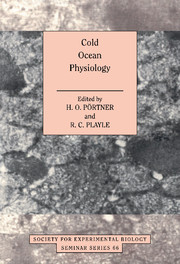Book contents
- Frontmatter
- Contents
- List of contributors
- Preface
- PART I General concepts
- PART II Compensatory adaptations in cold ocean environments
- PART III Exploitative adaptations
- PART IV Integrative approaches
- Effects of environmental and experimental stress on Antarctic fish
- Fish cardio-circulatory function in the cold
- Feeding, metabolism and metabolic scope in Antarctic marine ectotherms
- Evolution and adaptation of the diving response: phocids and otariids
- The physiology of polar birds
- PART V Applied approaches
- Index
Evolution and adaptation of the diving response: phocids and otariids
Published online by Cambridge University Press: 13 March 2010
- Frontmatter
- Contents
- List of contributors
- Preface
- PART I General concepts
- PART II Compensatory adaptations in cold ocean environments
- PART III Exploitative adaptations
- PART IV Integrative approaches
- Effects of environmental and experimental stress on Antarctic fish
- Fish cardio-circulatory function in the cold
- Feeding, metabolism and metabolic scope in Antarctic marine ectotherms
- Evolution and adaptation of the diving response: phocids and otariids
- The physiology of polar birds
- PART V Applied approaches
- Index
Summary
Although biologists have been intrigued by diving mammals and birds for well over a century, the physiological and metabolic mechanisms now known to permit an air breathing animal to operate successfully deep into the water column were first exposed in the 1930s and 1940s through the pioneering work of Scholander, Irving, and their colleagues (Irving et al., 1935; Scholander, 1940). The basis of their work provided the fundamental foundations of diving physiology, which are now known to include three key physiological ‘reflexes’: (i) apnea, (ii) bradycardia, and (iii) vasoconstriction and thus hypoperfusion of most peripheral tissues. Scholander referred to these physiological reflexes in combination as the ‘diving response’, and, in simulated diving under controlled laboratory conditions, he imagined the marine mammal reducing itself to a ‘heart, lung, brain machine’. The metabolic representation of this response included the gradual development of oxygen-limiting conditions in hypoperfused (ischaemic) tissues, with attendant accumulation of end products of anaerobic metabolism (especially lactate and H+ ions). Scholander realised that because peripheral tissues were hypoperfused, most of the lactate would remain at sites of formation during the course of a (simulated) dive, and that most of it would not be ‘washed out’ of the tissues into the circulation until perfusion was restored at the end of diving. By explaining why only a small lactate accumulation is observed in blood plasma during diving, while a peak of lactate is usually seen early in recovery from a dive, Scholander used the lactate data as indirect evidence for hypoperfusion and vasoconstriction of peripheral tissues.
- Type
- Chapter
- Information
- Cold Ocean Physiology , pp. 391 - 431Publisher: Cambridge University PressPrint publication year: 1998
- 6
- Cited by

